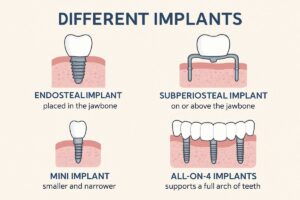The anchoring of a crown bridge or denture is the process that holds a dental prosthetic firmly in your mouth. Dental implants act like artificial tooth roots, giving strong support where natural roots are missing. This guide explains the anchoring of a crown bridge or denture in Kalispell, why it matters for chewing and long-term oral health, and what to expect if you choose implant support.
Whether you ride out temporary loose dentures or want a long-term fixed solution, understanding how implants anchor restorations helps you pick the right option and care for it properly.
What is the anchoring of a crown bridge or denture?
The anchoring of a crown bridge or denture means using implants to secure crowns, bridges, or dentures so they behave like natural teeth. Implants are titanium posts placed into the jawbone. Over time the bone fuses to the implant, creating a stable base to attach a crown, bridge, or denture.
This differs from traditional solutions that rely on adhesives, metal clasps, or simply resting on the gums. Those options can slip, cause sore spots, and allow faster bone loss. Implant anchoring restores function and helps preserve bone by passing chewing forces into the jaw like a natural root.
How implants anchor crowns, bridges, and dentures
Single-tooth implant + crown
One implant replaces one missing tooth. After healing, a custom crown is attached to an abutment on the implant. This option is ideal when just one tooth is missing. It provides strong biting force, looks natural, and protects adjacent healthy teeth because they do not need to be altered.
Implant-supported bridge
When several teeth in a row are missing, two or more implants can support a bridge. Fewer implants can replace multiple teeth because the bridge spans the gap. This reduces the number of surgeries and can give a fixed feel similar to natural teeth. Implant-supported bridges are stable and easier to clean than long removable options.
Implant-retained denture / overdenture
For full-arch tooth loss, implant-retained dentures snap onto implants with clips, locators, or bar systems. Clip/locator systems let the denture snap on and off for cleaning. Bar systems use a metal bar attached to implants; the denture clips onto that bar. These improve retention and chewing compared to traditional dentures. Some patients choose fully fixed prostheses that are screwed in and only removed by a dentist.
Benefits, limitations, timeline, and care
Key benefits of the anchoring of a crown bridge or denture include:
- Better chewing and speech
- Preserved jawbone and facial shape
- Greater comfort and stability than removable options
- Durability and long-term cost value
Limitations and risks to consider:
- Requires surgery and healing time
- Possible need for bone grafting if bone is thin
- Higher upfront cost than removable dentures
- Small risk of infection or implant failure
Typical timeline from consultation to final prosthetic:
- Consult and 3D imaging: exam, CBCT scan, and treatment plan (1 visit)
- Surgery: implant placement (same day or scheduled)
- Healing/osseointegration: usually 3–6 months depending on bone and procedure
- Abutment and impression or digital scan: prepare for final restoration
- Delivery of crown, bridge, or denture: final fit and adjustments
Basic aftercare tips:
- Keep soft tissues clean with gentle brushing and flossing around implants
- Use implants-safe interdental brushes or water flossers for bridges and bars
- Attend regular dental checkups and professional cleanings
- Avoid hard, sticky foods during early healing and protect restorations from trauma
Why choose Flathead Dental Implant Arts / Dr. Dave Dodrill
Flathead Dental Implant Arts blends experience and modern technology to improve the anchoring of a crown bridge or denture in Kalispell. Dr. Dave Dodrill (DDS) graduated cum laude and completed advanced training in general dentistry. He uses a patient-first approach and supports the community through volunteer work.
Key technologies that improve anchoring outcomes here include:
- CBCT imaging for precise bone and nerve mapping
- Digital implant planning software to place implants accurately
- In-house 3D printing of surgical guides and models
- Guided-surgery workflows and 3D-printed guides for predictable placement
- Digital impressions and CAD-CAM prosthetics for tight-fitting restorations
- Sedation options to make procedures comfortable
These tools create an integrated workflow that reduces surprises, shortens treatment time, and keeps costs more predictable. Flathead Dental Implant Arts focuses on minimally invasive care and long-term success.
If you want to learn more about the anchoring of a crown bridge or denture, schedule a consult with Flathead Dental Implant Arts. Dr. Dodrill and the team will review your options, show imaging, and recommend the best anchoring solution for your needs.




